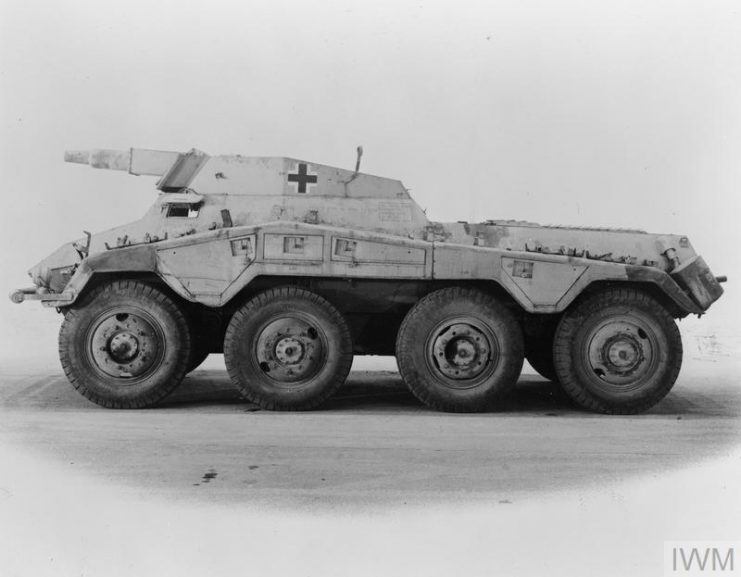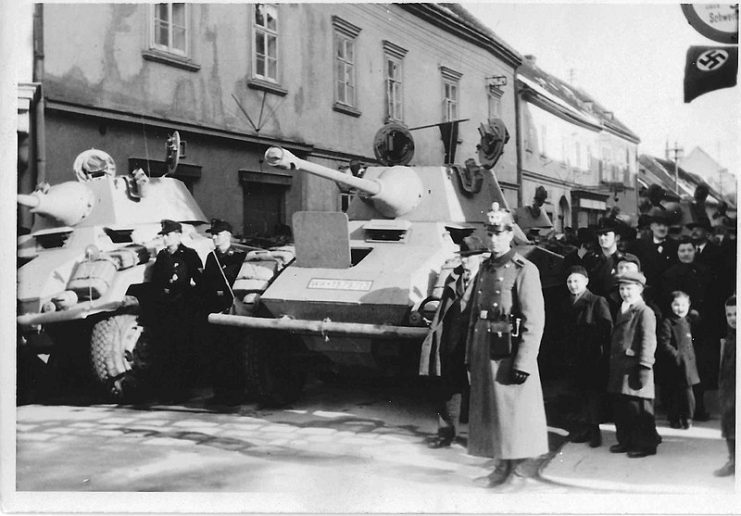I was looking at the models on one of my shelves and I decided to do a blog post on the "Special operation" units of the WWII German Army, I thought they were Otto Skorzeny group, but I was wrong,there was an older one that did well in their duties but the intercine warfare that the Germans engaged with each other spelled doom for the units despite their excellence and heroism.
Brandenburgers were the members of the first German special operations unit. They specialized in operating far behind enemy front lines, performing covert operations right under the eyes of their enemies. Bravery and guile were their weapons.
Most of their missions were covered by a veil of secrecy due to the fact that the unit was run by the Abwehr, or German military intelligence service. They were hated by soldiers of their own army as much as by their enemies.
Interestingly, before World War II the German Army was reluctant to form a commando style unit, seeing them as completely useless. Army officials believed that the might of their panzer units combined with blitzkrieg tactics was sufficient to crush any enemy.
It was therefore an Abwehr officer, Theodore-Gottlieb von Hippel, who successfully pushed the idea of forming a special unit that would perform “irregular” tasks which standard units were not capable of carrying out.
Colonel Paul von Lettow-Vorbeck "The Lion of Africa"
Theodore Hippel was a World War I veteran who had spent his war days
in East Africa under the command of Colonel Paul von Lettow-Vorbeck.
During the war Colonel Lettow-Vorbeck led local Askari tribes in
fighting British colonial troops. With scarce resources, fighting an
irregular warfare, they managed to cause a lot of problems for the
numerically superior British.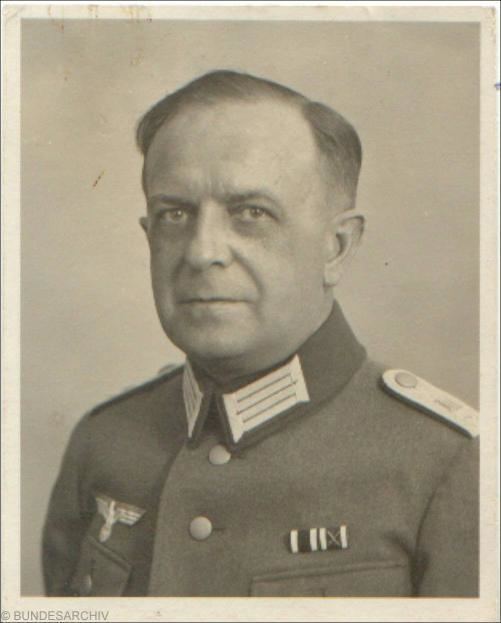
The experience he gained during this period made Hippel a great advocate of irregular warfare. Upon returning to Germany, he studied the campaign of Lieutenant Colonel Thomas Edward Lawrence against the Ottomans in the Middle East. Hippel was more than impressed with their tactics and was certain that a similar type of warfare could be used in Europe as well.
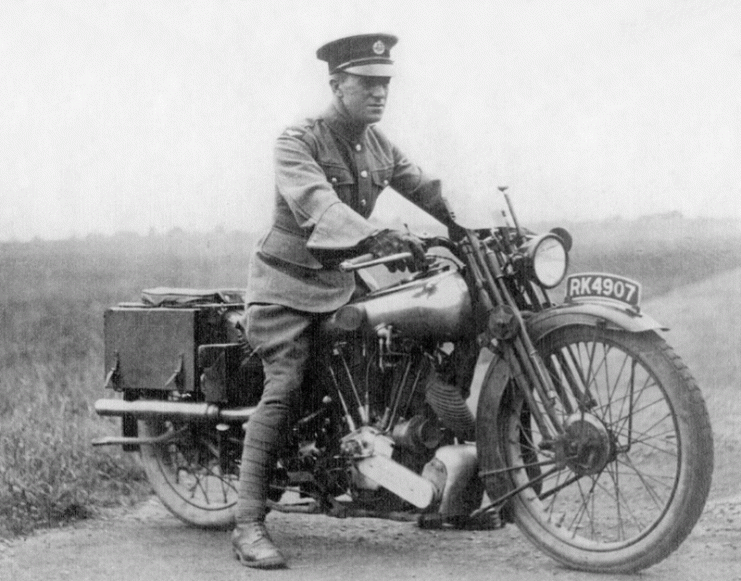
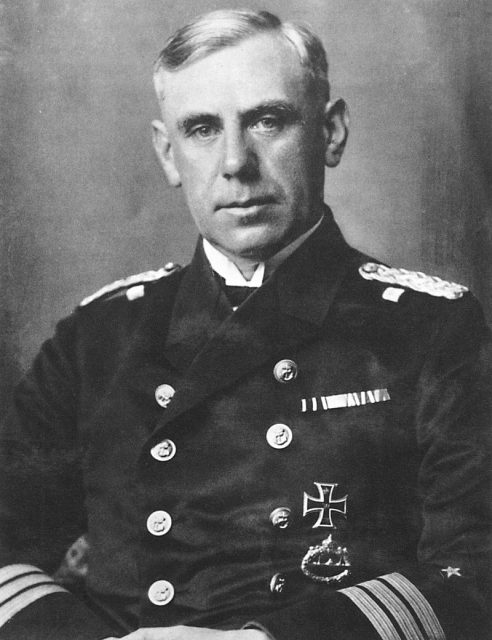
Captain Theodore Hippel was tasked with gathering recruits for the new unit. Among them were misfits and men with doubtful pasts, but there were also ordinary men willing to help their country.
Brandenburgers were everything but conventional soldiers. What Hippel was looking for were people who primarily had excellent knowledge of foreign languages and were familiar with the customs of nations that were targeted for German invasion. Soldiers with such skills were more likely to successfully infiltrate and then keep a low profile while operating.
Besides Germans, other nationalities were included too. Most of these foreigners joined with the hope that German troops would bring liberation to their own nations. Other foreigners were simply sympathizers of the Nazi regime and wanted to contribute to the establishment of the New Order.
Contrary to the practices of the SS, the Abwehr didn’t give much thought to the racial background of its operatives as long as they were doing their tasks properly. For that reasons, Brandenburgers included Tatars, Slavs, and others that were considered by the Nazis as impure.
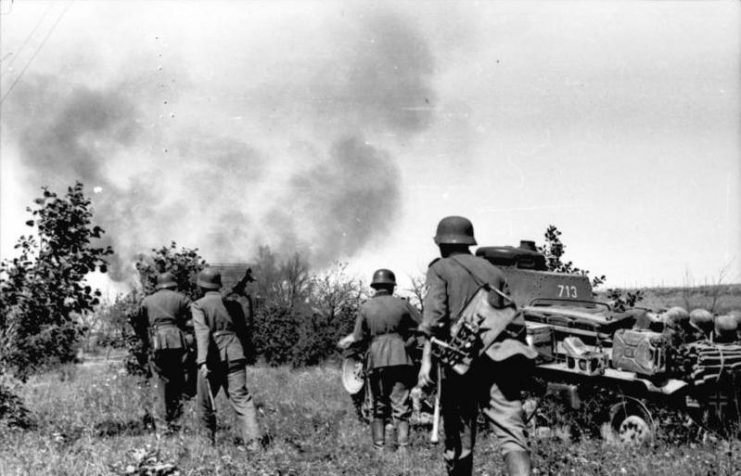 Russia-North, Brandenburgers and a Panzer 35t. Photo: Bundesarchiv
Shortly before the war, the first special operations unit was formed. It was called Deutsche Kompanie (“German
Company”). Recruits were trained in the special abilities required for
diversions and urban and guerilla warfare. Special attention was given
to working in small formations and gaining navigation and survival
skills. All combat trainings were performed with live ammunition!
Russia-North, Brandenburgers and a Panzer 35t. Photo: Bundesarchiv
Shortly before the war, the first special operations unit was formed. It was called Deutsche Kompanie (“German
Company”). Recruits were trained in the special abilities required for
diversions and urban and guerilla warfare. Special attention was given
to working in small formations and gaining navigation and survival
skills. All combat trainings were performed with live ammunition!In order to infiltrate successfully behind enemy lines, Brandenburgers learned about enemy formations and commands. For complete deception, Brandenburgers wore enemy uniforms. These were obtained in every possible way. Dutch uniforms were, for example, bought in second-hand shops. Soviet uniforms were obtained from Finns who had captured some during the Winter War in 1939-1940.
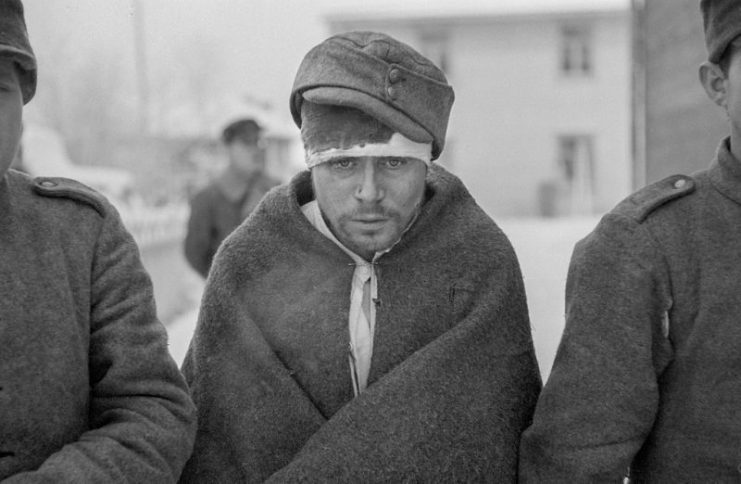
Learning to use foreign weapons was necessary as well. It was presumed that out there behind enemy lines, Brandenburgers would have to use captured weapons, especially because on most occasions they went to combat armed only with small arms and grenades.
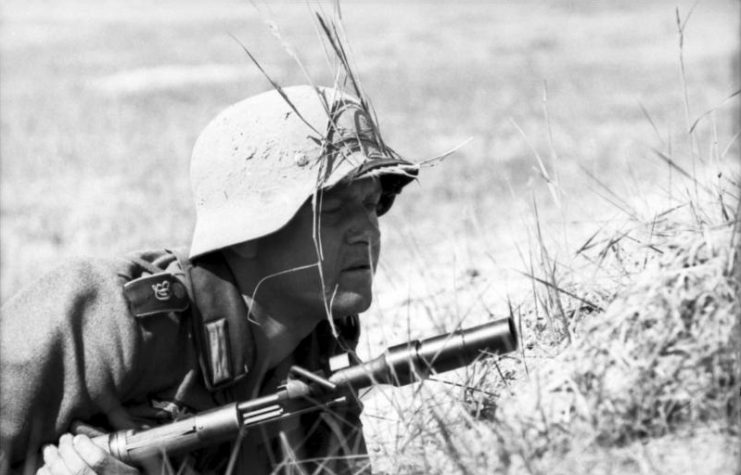
These were the first special operations missions in WWII. However, apart from their success on the battlefield, soldiers of the German Company were remembered for numerous atrocities against local populations.
Satisfied with what he had seen in Poland, Canaris approved the forming of Bau-Lehr-Kompanie z.b.V. 800, or “Special Duty Training and Construction Company No. 800,” on 25 October 1939. The company was designated as a construction unit purely as a cover.
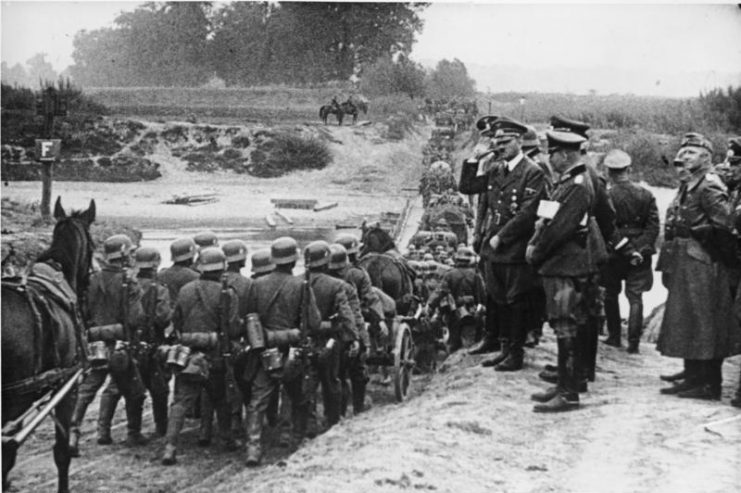 Hitler watching German soldiers marching into Poland
Hitler watching German soldiers marching into PolandUnder the charge of Captain Theodore Hippel, the unit’s command was established in the town of Brandenburg-an-der-Havel, thus earning the nickname “Brandenburgers” for its soldiers.
The unit was organized as part of the Abwehr’s Abteilung II, or 2nd Department. This department was in charge of activities outside German borders and was considered to be the most aggressive part of the Abwehr.
The unit was quickly expanded to the level of Battalion on December 15, 1939 and then to the level of Regiment on June 1, 1940.
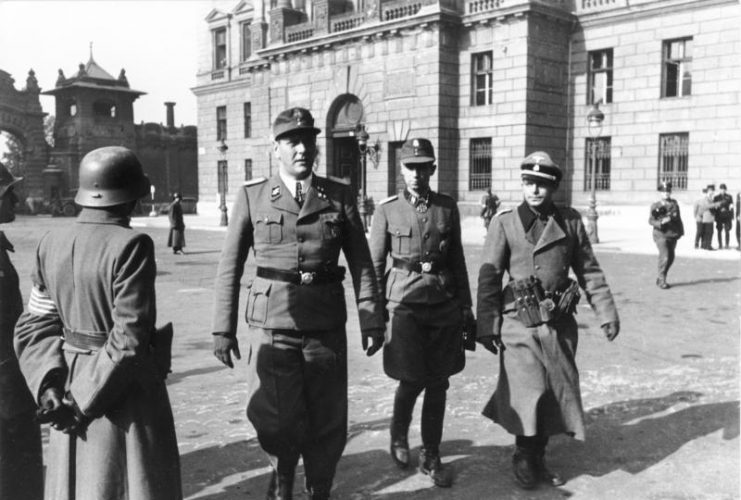
Despite the fact that they were still being disrespected by Army officers, Brandenburgers made a big contribution to the victory of the Blitzkrieg in the Lowlands and France. By seizing and securing vital communication spots, such as bridges and railroad junctions, they ensured the quick movement of German troops. Without that, the Blitzkrieg would have definitively lost momentum in the early stages of the invasion.
One of the most spectacular operations the Brandenburgers conducted was seizing the railway bridge near the Dutch town of Gennep. This bridge was vital for the German plan of reaching Dutch defensive positions at the Peel Line before the Dutch could properly man them.
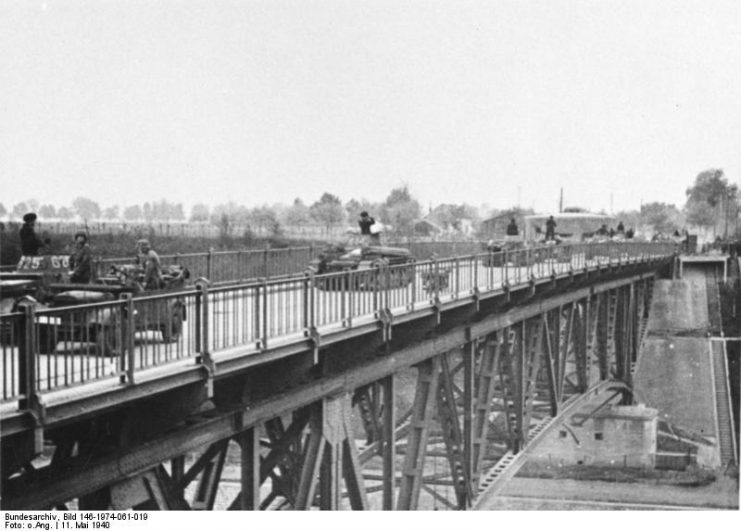
As the four disguised prisoners walked across the bridge, the guards at the western end of the bridge spotted a German train coming. Before they could figure out what was happening, the bridge guards found themselves caught in a crossfire between the four fake captives and German soldiers on the train.
In just a few moments, the guards were overpowered and the bridge was secured. Later that day, the 9th Panzer Division quickly moved across the bridge.
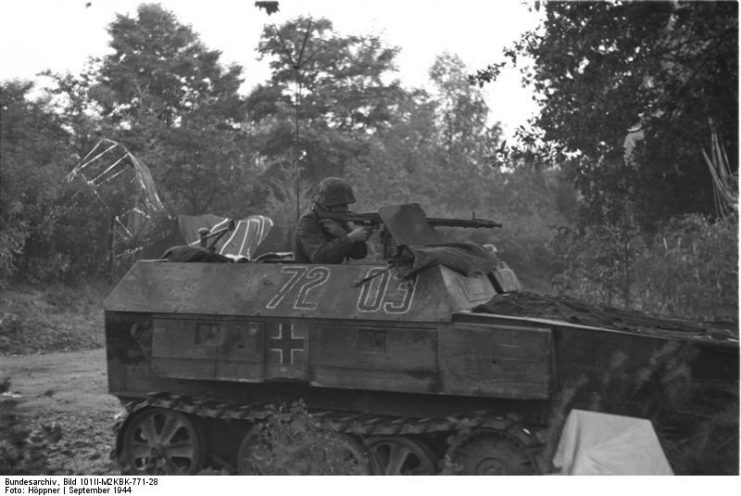 9th SS Panzer Division Hohenstaufen.Photo: BundesarchivAfter the 1940 campaign in the West, there was hardly anyone who
still doubted the usefulness of the Brandenburgers. As the German
conquest of Europe continued in 1941 and 1942, the Brandenburgers
continued to impress with their daring missions. The mission that they
carried out during the 1942 Summer Offensive in the Soviet Union was a
most impressive one.
9th SS Panzer Division Hohenstaufen.Photo: BundesarchivAfter the 1940 campaign in the West, there was hardly anyone who
still doubted the usefulness of the Brandenburgers. As the German
conquest of Europe continued in 1941 and 1942, the Brandenburgers
continued to impress with their daring missions. The mission that they
carried out during the 1942 Summer Offensive in the Soviet Union was a
most impressive one.In the summer of 1942, the entire Brandenburg regiment was transferred to Ukraine to support the German offensive toward Stalingrad and the Caucasus oil fields. 8th Company of the 3rd Battalion received an order to help Army Group A units to seize the city of Maikop, an oil-producing center in the northern Caucasus.
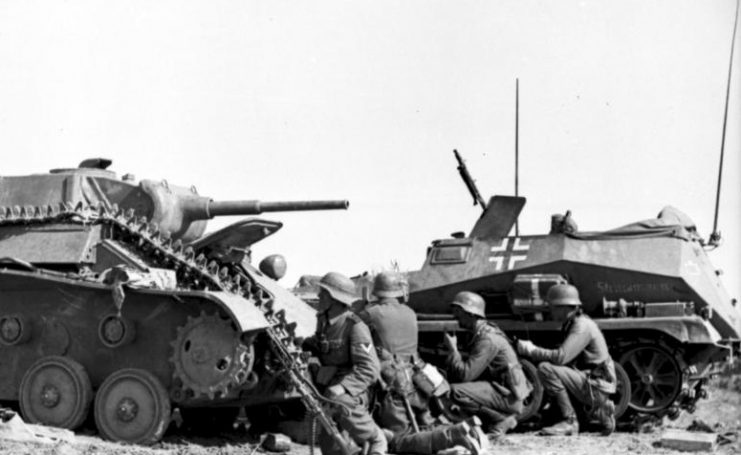
On August 8 the Brandenburgers commenced their action. Split up in three groups, they seized the main oil storage tanks and key communication posts, which they then used to issue fake withdrawal orders to Red Army troops inside and in the vicinity of the town. On the following day, when the offensive began, the spearhead of the 13th Panzer Division took control of the city.
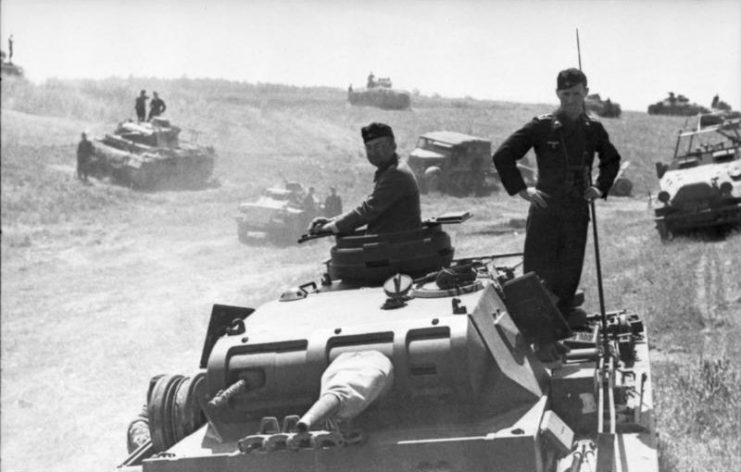
The best way to do so was to form a similar unit, but under the control of SS. In April 1943, the SS version of the Brandenburgers was formed: Friedenthaler Jagdverbande (“Friedenthal Hunting Groups”). Command over these small units was given to Captain Otto Skorzeny of the Waffen-SS, a man who became synonymous with German commando warfare.
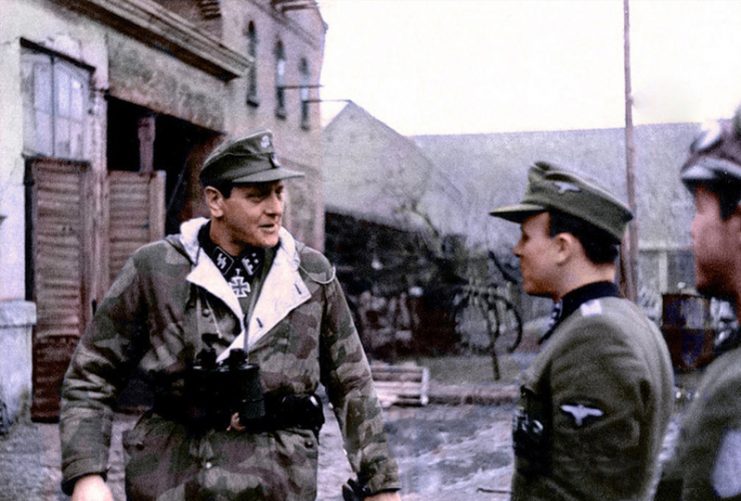 SS Officer Otto Skorzeny, who helped organize and train the paramilitary “werewolf” forces that were never successfully deployedEven though the unit was only a few months old, Himmler managed to
persuade Hitler to task the Friedenthalers with the daring mission of
rescuing Benito Mussolini from captivity at Gran Sasso. The success of
Skorzeny and his men in this operation meant the end for the
Brandenburgers.
SS Officer Otto Skorzeny, who helped organize and train the paramilitary “werewolf” forces that were never successfully deployedEven though the unit was only a few months old, Himmler managed to
persuade Hitler to task the Friedenthalers with the daring mission of
rescuing Benito Mussolini from captivity at Gran Sasso. The success of
Skorzeny and his men in this operation meant the end for the
Brandenburgers.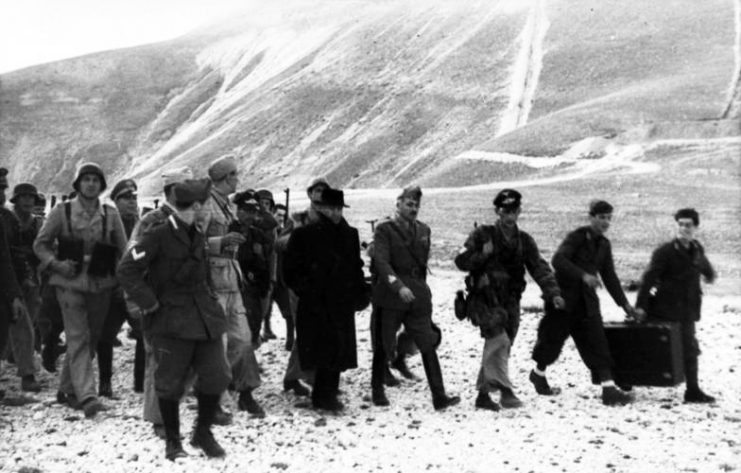
As time passed, the Friedenthalers took the role of the Brandenburgers, who on the other hand were gradually transformed into a standard Army unit. The process ended on September 15, 1944 when the division was redesignated as Panzergrenadier-Division Brandenburg. All 900 officers, NCOs, and soldiers who specialized in commando warfare were transferred to SS Jagdverbande units.














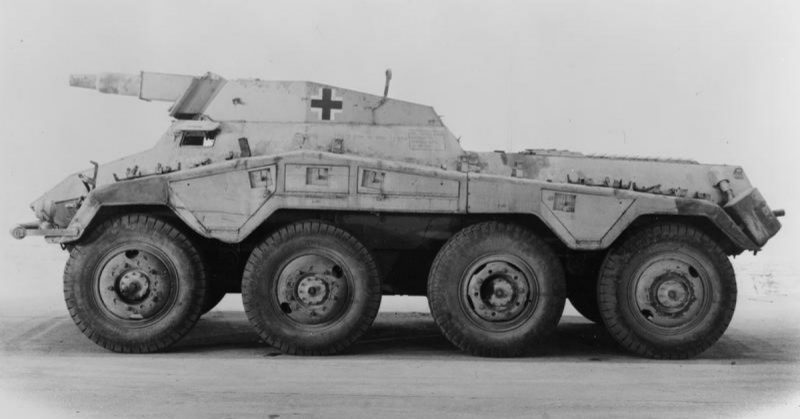
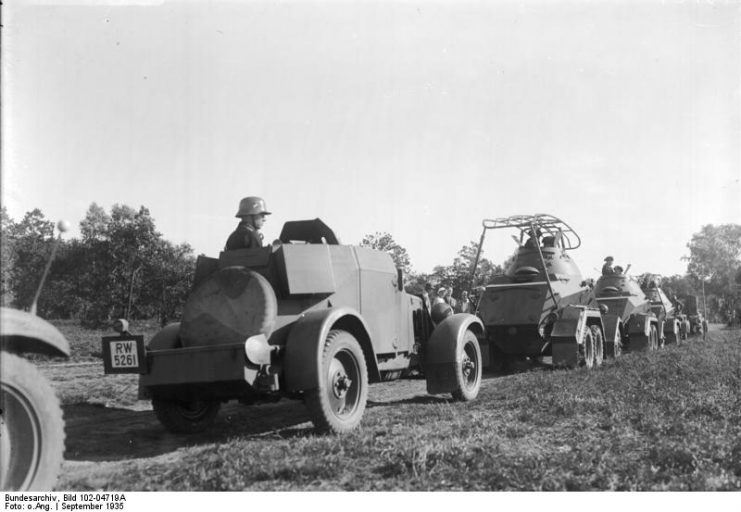
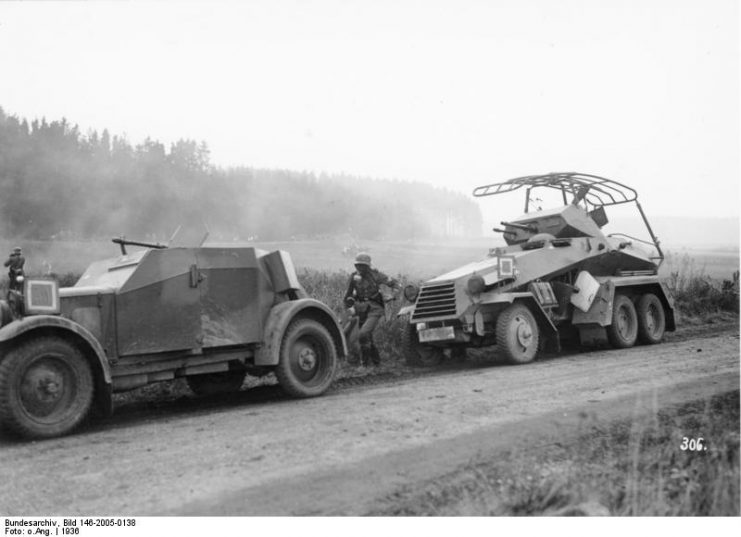 Left:
a Kfz 13; right: an armoured Sd.Kfz. 232 with large loop antenna
(6-wheeled radio and command vehicle).Photo: Bundesarchiv,
Developed by Auto-Union/Horch and serving from 1935, the Sd Kfz 221
was the smallest of the specialist armored cars that superseded the Kfz
13. This time, the chassis was specially developed for military
purposes, with a rear engine, four-wheel drive, low-range gears suited
to cross-country travel, and sloped side armor. Its open-topped turret
usually carried a 7.93mm machine gun, though some were equipped with an
anti-tank rifle.
Left:
a Kfz 13; right: an armoured Sd.Kfz. 232 with large loop antenna
(6-wheeled radio and command vehicle).Photo: Bundesarchiv,
Developed by Auto-Union/Horch and serving from 1935, the Sd Kfz 221
was the smallest of the specialist armored cars that superseded the Kfz
13. This time, the chassis was specially developed for military
purposes, with a rear engine, four-wheel drive, low-range gears suited
to cross-country travel, and sloped side armor. Its open-topped turret
usually carried a 7.93mm machine gun, though some were equipped with an
anti-tank rifle.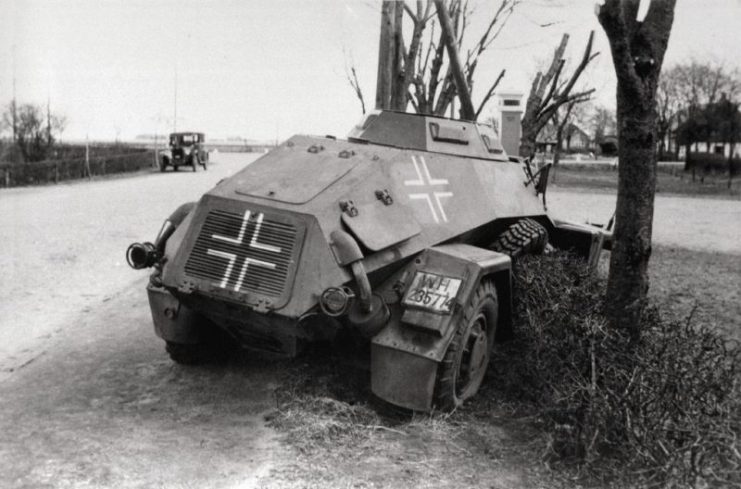
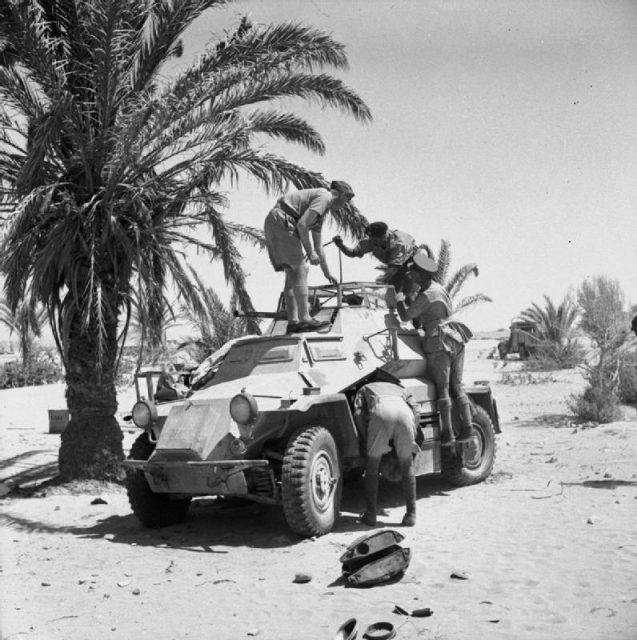
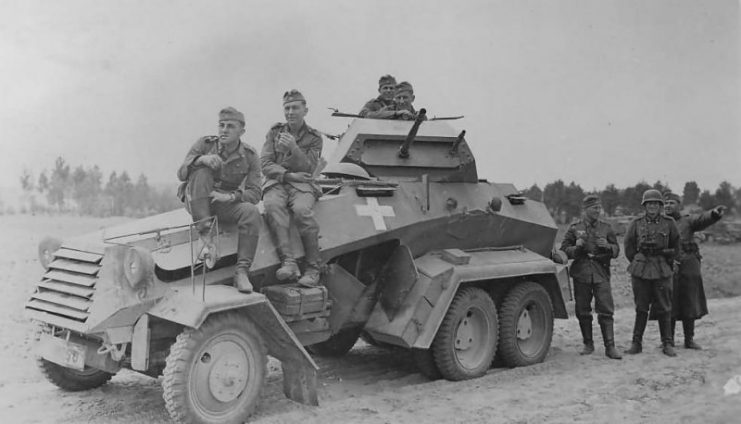
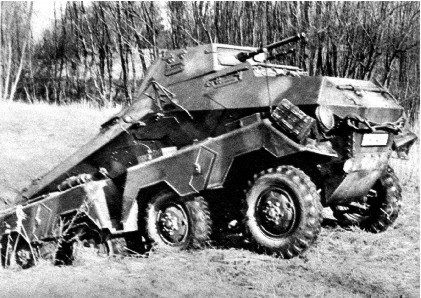
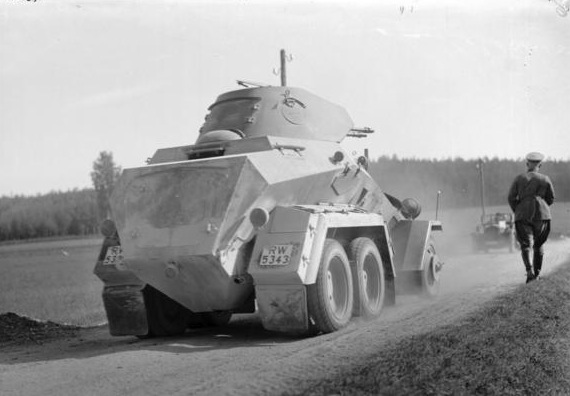
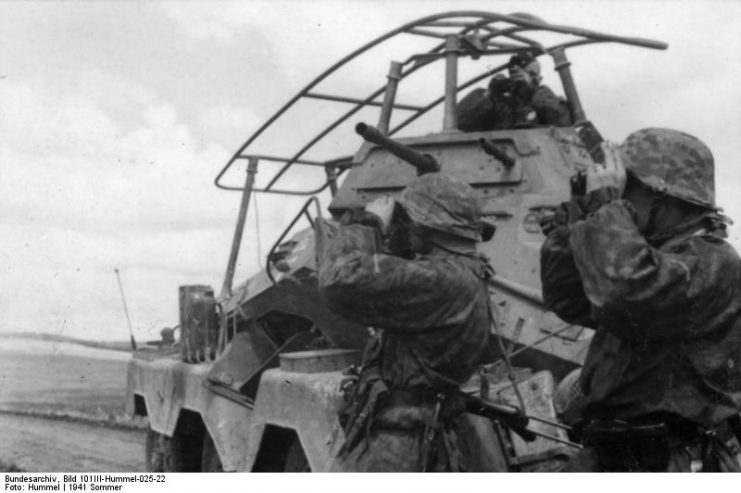 8 Rad Sd.Kfz. 232 radio vehicle of the 5th SS Panzer Division Wiking in Russia, 1941.Photo: Bundesarchiv, BildThe Sd Kfz 232 had an armored body built over a relatively slender
chassis. It was originally equipped with a 7.92mm machine gun and a 20mm
automatic cannon, but this was later upgraded to a short 75mm gun, with
this more heavily armed vehicle given the designation Sd Kfz 233.
Despite its complex mechanical layout, this series of vehicles became
very popular with the army and they were widely used.
8 Rad Sd.Kfz. 232 radio vehicle of the 5th SS Panzer Division Wiking in Russia, 1941.Photo: Bundesarchiv, BildThe Sd Kfz 232 had an armored body built over a relatively slender
chassis. It was originally equipped with a 7.92mm machine gun and a 20mm
automatic cannon, but this was later upgraded to a short 75mm gun, with
this more heavily armed vehicle given the designation Sd Kfz 233.
Despite its complex mechanical layout, this series of vehicles became
very popular with the army and they were widely used.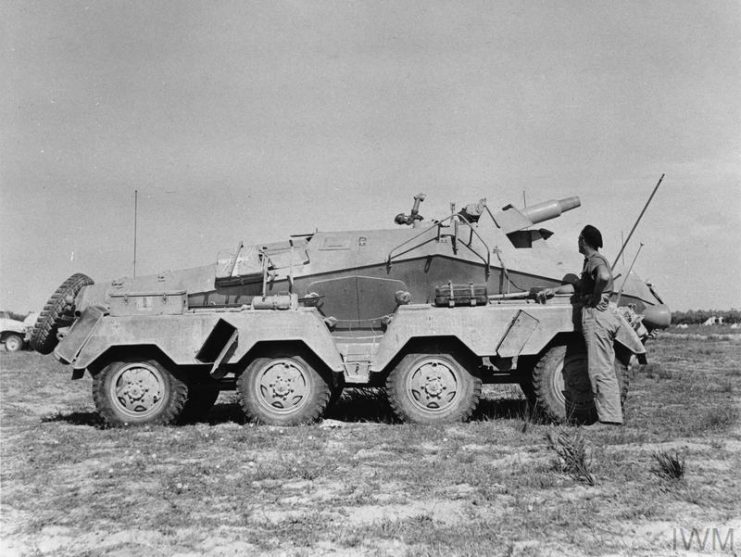
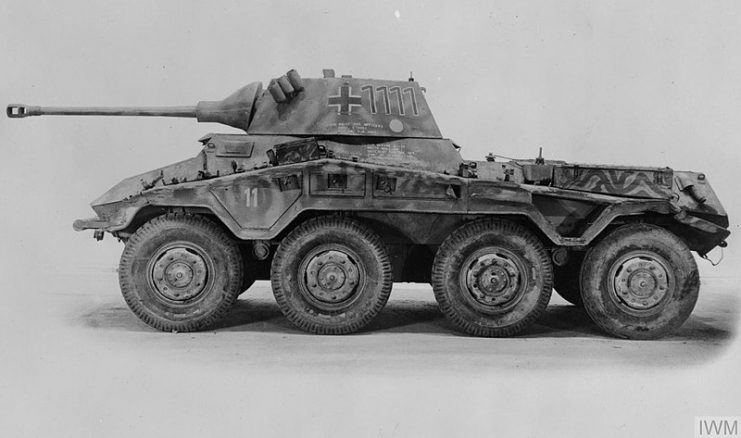
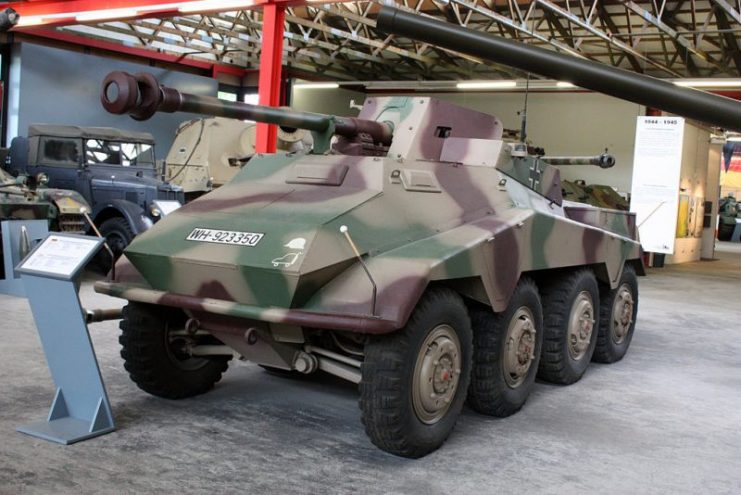 Sd.Kfz. 234 4 Pakwagen, Munster Panzermuseum, Germany
Sd.Kfz. 234 4 Pakwagen, Munster Panzermuseum, Germany
